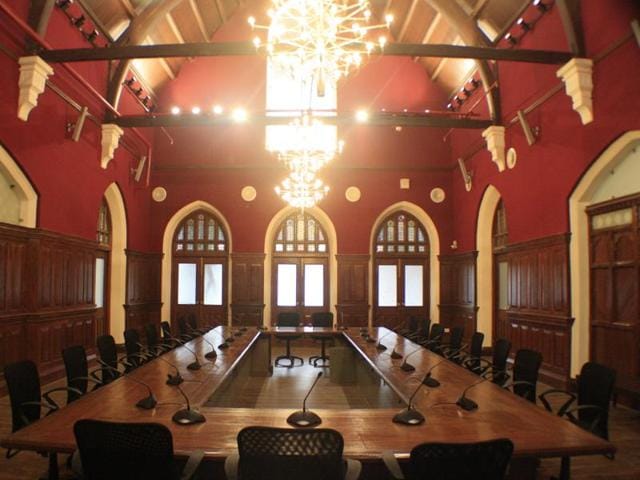For its 123rd birthday, BMC building gets a grand makeover
Take a look at before-and-after photos of the courtyard, stained-glass, Burma teak panels and inner chambers of your municipal headquarters.
They’re two masterpieces facing each other, and one usually gets all the attention.

But if you look up as you step out of Chhatrapati Shivaji Terminus, you can’t but be amazed by the architectural marvel facing it, the Brihanmumbai Municipal Corporation (BMC) headquarters.
It is everything a building of its stature should be — grand, regal, imposing.
Perched on a central gable is a majestic winged statue bearing the inscription ‘Urbs prima in Indis’ which refers, in Latin, to Bombay being the ‘First City of India’.
Read: A city within a city - get a glimpse into Mumbai’s rich heritage
Topping it all is a massive central dome supported by a 255-ft-tall main tower.
Like CST, the BMC HQ was also designed by the architect Frederick William Stevens. He sketched it in 1893, and it took nine years to build.
In more recent times, a painstaking restoration has taken nearly as long. Work on the Victorian-era, Neo-Gothic structure has been underway since 2008, undertaken by conservation firm Abha Narain Lambah and Associates. Now, just in time for the 123rd anniversary of its completion on July 31, the work too has been declared complete.
“Our primary objective was to save any material that was of historic importance,” says conservation architect Lambah. “Right from the tiles to antique furniture, stained-glass windows and even the Burma teak rafters, we have salvaged as much as we could of the original structure.”

The grand central stairway
The first thing you see as you enter is a sweeping stone staircase rising out of the softly lit central hall, flanked by a statue of a winged lion on either side.
“The huge stone lion is a mascot, representing the courage and power that is associated with the most important administrative building in the city,” says Arvind Vichare, 57, a maintenance department employee and custodian of the building. “The British might have built it as a sign of authority, but now it is a part of the heritage we are proud of.”
Each stair is made from a single uncut slab of the stone, Vichare adds.
Minton tile flooring
The original Minton tiles in the flooring have been retained wherever possible and, where necessary, replaced with replica Bharat tiles, to maintain the aesthetics.
Raising the roofs

Crumbling false ceilings have been removed and ornamental wooden arches polished to give the rooms a more spacious and modern feel while also restoring and highlighting the beauty of the original architecture of the interiors. The wooden counters at the Citizen Facilitation Centre and several similar panels across the building, all of which were over a century old, were refurbished. Since most were made of Burma teak, all they needed was some buffing to glow again as they must have when they were first installed.
Furniture and air-conditioning
Some of the vents in the building dated back to the 19th century, Lambah says, and were circular spaces made so that ‘chamber boys’ could operate hand-held fans for the sahebs without having to be in the room. “We decided to draw wires through these in a way that would merge with the décor of the room,” she says.
Rickety old benches in the corridors and verandahs, meanwhile, have been replaced with sleek two-toned chairs and plush couches. Clunky steel cupboards have given way to similar space-saving cabinets.
Read: A peek into the past, via the relic hunters of Mumbai
“We have restored the antique cupboards and historic furniture, but have de-cluttered the space by doing away with steel racks and shelves, which were introduced in the later stages. Creaky fans with long downward rods and oddly placed ducts have been replaced with air-conditioning,” Lambah says.
Stained-glass windows
One of the biggest challenges of the restoration was repairing the stained-glass windows.

“In some cases it was physically difficult to even reach all the cracks — as with the gigantic rose windows in the attic that are over 10 feet in diameter,” says Parveen Mistry of Glass Sensations, which supervised this arm of the project. “Also, special restoration glass had to be imported from the UK and delicately replaced where necessary.”
Courtyards and fountains

The Rs 50 crore-renovation project also included a revamp of the courtyard, to make space for an amphitheatre, and restoration of the marble-and-stone fountain.

The author tweets @aneshageorge




